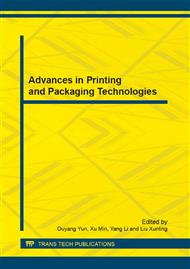p.269
p.273
p.278
p.282
p.287
p.291
p.297
p.302
p.307
A Study of Print Quality of UV Ink-Jet Printing on Glass
Abstract:
The global trend of digitization has totally varied the printing production processes. Among different printing technologies, digital ultraviolet (UV) ink-jet printing has strengths of easy to dry, printing on unsmooth surface, easy to print with different substrates and lower cost, and hence was commonly adopted by different industries. This study was to evaluate the print quality and weathering resistance of UV ink-jet printing on glass. The UV inks, from companies of AGFA and Anderson companies, and Primer adhesive and white ink from a domestic company were adopted in this study. Four types Primer were applied, i.e. without Primer, one layer of Primer, three layers of Primer, and five layers of Primer, before the print test target was printed. Two types of inks from AGFA and Anderson were used by a UV ink-jet printer to print out the test target. A spectrophotometer was used to measure the test charts, and the print quality was analyzed in terms of color contrast, solid ink density, ink trapping, dot gain or tonal value increment, gray level, etc. The experiment showed that test targets printed with two types of inks had no significant difference both on printability and print quality. However, the Anderson ink had slightly better print quality, weathering resistance, wear resistance, and adhesion compared to those of AGFA’s. Glass printed with Primer and white ink layers in advance had better printability and color quality in the experiment. Overall, UV ink-jet printing on glass had excellent printability and color performance. The results of this study can be referred by industries.
Info:
Periodical:
Pages:
287-290
Citation:
Online since:
December 2012
Authors:
Keywords:
Price:
Сopyright:
© 2013 Trans Tech Publications Ltd. All Rights Reserved
Share:
Citation:


